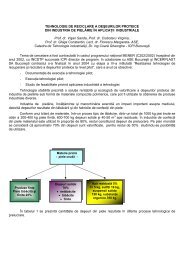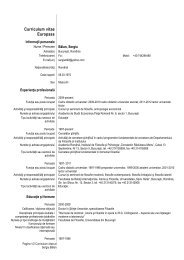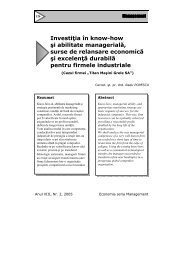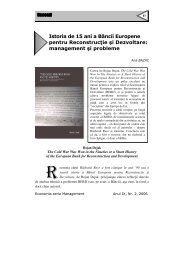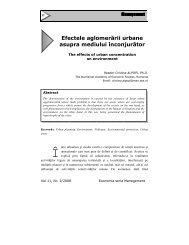Norlizan MAT RABI, Abdul Hadi ZULKAFLI, Mohd Hassan CHE HAAT
Norlizan MAT RABI, Abdul Hadi ZULKAFLI, Mohd Hassan CHE HAAT
Norlizan MAT RABI, Abdul Hadi ZULKAFLI, Mohd Hassan CHE HAAT
Create successful ePaper yourself
Turn your PDF publications into a flip-book with our unique Google optimized e-Paper software.
Economia. Seria Management Volume 14, Issue 1, 2011<br />
In terms of IT investments for banks, the Apache server license is free for commercial use,<br />
Microsoft IIS is part of the operating system and its license cost is included in the operating<br />
system license costs, IBM HTTP Server is free for use and the support from the vendor is<br />
charged separately.<br />
4. An Analysis of Romanian Banks’ Presence on Social Networks<br />
The relations with clients underwent strong transformations after the Internet boom. New<br />
communication tools are available and can be exploited successfully to gather feedback<br />
from clients, to get a better insight of customers’ expectations and needs as well as to<br />
promote the bank’s financial products.<br />
Even if the SEO-based analysis revealed an openness in using e-mail for communication, as<br />
a range of 2 to 1476 mailto protocol usages were identified in each bank website, the real<br />
time communication in a public social network or in private is likely to bring more value to<br />
the client-bank relationship, especially among younger customers. The messenger protocol,<br />
ymsgr, was discovered only on one bank website and its purpose was to facilitate the<br />
sending of a video over Yahoo Messenger.<br />
The Romanian banks adhered to the professional network Linkedin in a large proportion.<br />
As for the more informal social networks, like Facebook or Netlog, banks interact generally<br />
with young customers in order to try to better understand their needs regarding banking<br />
products and collect feedback.<br />
On Netlog, only BCR and ING Bank Romania had profiles on the 2nd of October 2010,<br />
when this research was carried out, and both of them intensively promoted their students<br />
offer and cards offer in their Netlog accounts. Also, various quizzes and polls were opened<br />
for visitors. On the other hand, on Facebook, some Romanian banks take advantage of their<br />
online presence to stress upon their social responsibility actions, give news about the<br />
territorial units extension and new agencies, products promotions, as well as to provide a<br />
brief overview of key financial performance indicators of the bank.<br />
Regarding the usage of Twitter, Romanian banks are even more reluctant to possible<br />
benefits. The few banks represented on Twitter use it either as a notification channel for the<br />
exchange rates & new product offers, or in a true conversational manner to support and<br />
advice customers in different banking problems. An example of good practice in using<br />
Twitter is ING Bank (http://twitter.com/webcard_ro) that acts as a real-time interaction &<br />
counseling tool between customers and bank representatives on various banking issues, also<br />
used to test the customers attitude before launching a new financial product/service.<br />
From the investments’ point of view, adhering to these social networks is free of charge and<br />
the only costs involved are related to the human resource allocated to operate on them. The<br />
benefits reflect in increased customers’ loyalty to the brand, attracting new clients,<br />
obtaining feedback, increased brand reputation, one to one and one to many marketing.<br />
97



